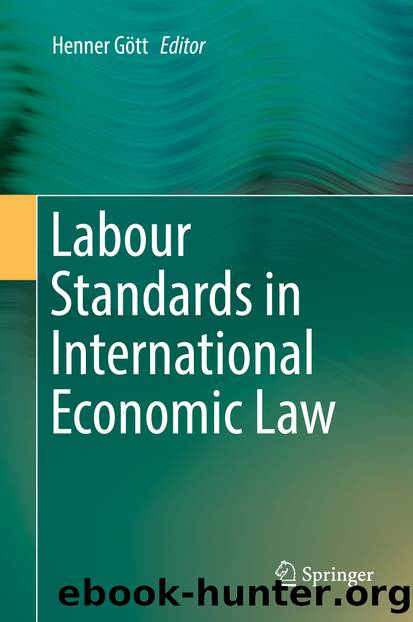Labour Standards in International Economic Law by Henner Gött

Author:Henner Gött
Language: eng
Format: epub
Publisher: Springer International Publishing, Cham
4 Effect of ‘Non-labour’ Provisions on Labour Standards
4.1 Economic and Labour Market Political Impact
TTIP advocates argue that the new free trade agreements would offer a huge potential for growth. The EU Commission for example published in the CEPR-Report figures about enormous positive growth and employment stimuli provided by TTIP,19 similar conclusions were reached by two IFO institute studies commissioned by the Bertelsmann Foundation and the German Federal Ministry of Economics and Technology, respectively.20 But a closer look to the CEPR-Report shows that the expert opinion on behalf of the EU Commission assumes an average GDP growth of about 0.04 percentage points per year for the EU (0.03 percentage points for the USA).21 Given the simulation period of 10 years, these stimuli would be marginal.22 On closer inspection, no additional employment impulses can be expected as a result of TTIP because possible increasing demands for labour in expanding sectors contrast with a reduction of labour in others, so that in the long run employment levels are expected to remain constant.23 The significant long-term increase in per capita income forecast in the IFO studies about a comprehensive free trade agreement (measured in real GDP per head)24 is considered unrealistic by other economists because of the underlying method of calculation.25
Critical economists arrive at different and emphatically more negative results because they take into account possible negative effects of the agreement which are not included in the other studies. Because of the social and macroeconomic costs of TTIP, some studies calculate the benefit to the national economy as 40% less than in the study undertaken on behalf of the EU Commission.26 Some reports therefore expect adjustment and transition losses to occur, as job relocation is likely to exceed the scale mentioned in the IFO studies.27 A Tufts university survey even forecasts net losses in exports and GDP after a decade, as well as a lowering of net take-home-pay and the loss of 600,000 jobs.28 The forecast for Germany is for net export losses of −1.14%, a GDP reduction of −0.29%, a decrease in net earnings by −€3400 per employee and the loss of 134,000 jobs.29
Download
This site does not store any files on its server. We only index and link to content provided by other sites. Please contact the content providers to delete copyright contents if any and email us, we'll remove relevant links or contents immediately.
The Meaning of the Library by unknow(2508)
Six Billion Shoppers by Porter Erisman(2268)
Why Nations Fail: The Origins of Power, Prosperity, and Poverty by Daron Acemoglu & James Robinson(2237)
No Time to Say Goodbye(2063)
Red Notice by Bill Browder(2028)
The Economist [T6, 22 Thg9 2017] by The Economist(1892)
Currency Trading For Dummies by Brian Dolan(1883)
Thank You for Being Late by Thomas L. Friedman(1739)
Bitcoin: The Ultimate Guide to the World of Bitcoin, Bitcoin Mining, Bitcoin Investing, Blockchain Technology, Cryptocurrency (2nd Edition) by Ikuya Takashima(1666)
Amazon FBA: Amazon FBA Blackbook: Everything You Need To Know to Start Your Amazon Business Empire (Amazon Empire, FBA Mastery) by John Fisher(1543)
Coffee: From Bean to Barista by Robert W. Thurston(1489)
The Future Is Asian by Parag Khanna(1440)
The Great Economists by Linda Yueh(1435)
Pocket World in Figures 2018 by The Economist(1391)
How Money Got Free: Bitcoin and the Fight for the Future of Finance by Brian Patrick Eha(1388)
Grave New World by Stephen D. King(1387)
Capitalism Without Capital: The Rise of the Intangible Economy by Jonathan Haskel(1376)
The Sex Business by Economist(1347)
Cultural Intelligence by David C. Thomas(1265)
